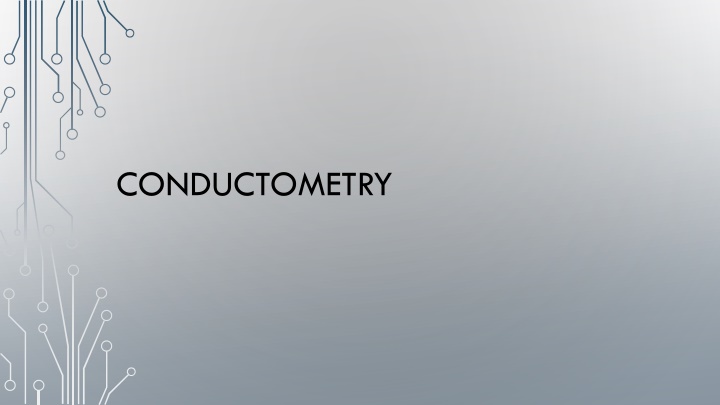
Conductometry and Conductivity in Solutions
Explore the concepts of conductometry and conductivity, including the measurement of a material's ability to transmit electrical current, the conductivity of water, and the use of conductometric titration in chemical analysis. Learn about the components of a conductometer and how conductivity changes are utilized in titration methods.
Download Presentation

Please find below an Image/Link to download the presentation.
The content on the website is provided AS IS for your information and personal use only. It may not be sold, licensed, or shared on other websites without obtaining consent from the author. If you encounter any issues during the download, it is possible that the publisher has removed the file from their server.
You are allowed to download the files provided on this website for personal or commercial use, subject to the condition that they are used lawfully. All files are the property of their respective owners.
The content on the website is provided AS IS for your information and personal use only. It may not be sold, licensed, or shared on other websites without obtaining consent from the author.
E N D
Presentation Transcript
CONDUCTIVITY Conductivity is the measure of A material's ability to transmit electrical current. C = 1 / R. Unit of conductivity is S.m-1.
CONDUCTIVITY OF WATER Theoretically, pure water does not transmit electric current. Hence it does not contain ions. But in practice, even pure water has a concutivity value. Whether or not a water is pure can be understood by looking at the conductivity value.
CONDUCTIVITY OF WATER For example, when the conductivity of ultrapure water is 0.055 S / cm and the conductivity of distilled water is about 0.5 S / cm, this value is around 56000 S / cm in seawater.
CONDUCTOMETER The analysis method based on the conductivity changes in the solution is called conductivity measurement (conductometry). The means used to measure conductivity is called a conductometer.
CONDUCTOMETER Conductometer consist of an electrical source, a conductivity cell in which the analysis solution is located, and a resistance meter. Platinum electrodes coated with platinum black are usually used in the conductivity cell.
CONDUCTOMETRIC TITRATION The concentration of the unknown concentration (analyte) is the type of titration in which the turning point is determined by using the changes in conductivity during the reaction with the known titrant.
CONDUCTOMETRIC TITRATION Conductometric titration is one of the most suitable methods which are widely used in the analysis of dark colored or unclear solutions and in precipitation reactions.

